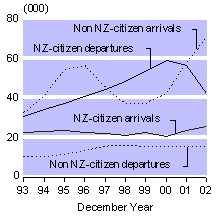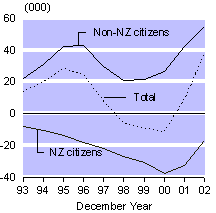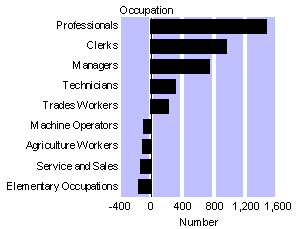I'm Gone for Now - but I'll Be Back!
Why Even Leave?As Oscar Wilde should have said, when bad ideas have nowhere else to go, they emigrate to America and become university courses. -
Frederic Raphael Government's Balance Sheet in the Black - CullenThe Government's balance sheet is in the black for the first time since records began, Finance Minister Michael Cullen said. Dr Cullen told the Canterbury Manufacturers' Association that total Government assets minus debt, including the New Zealand Superannuation Fund, were in the black for the first time since 1972, when records started being kept. The information is contained in the detailed Crown financial statements for the 9 months of the financial year to be issued tomorrow. Dr Cullen used the result to praise the Government's financial management. "We have enjoyed strong economic growth and strong revenue streams as a result," he said. "But we have spent and invested wisely, built up assets like the New Zealand Superannuation Fund (currently $9.2 billion) and repaid debt to the extent that we can now celebrate an enviable status among developed nations." New Zealand was one of seven OECD countries with positive net financial assets. As at March 31, net financial assets totalled $400 million. "We got there earlier than expected thanks to higher than expected returns by the New Zealand Superannuation Fund and foreign exchange gains." Dr Cullen said the Budget on 18 May would show the net financial asset position continuing to improve over the 4-year forecast horizon. "We have buried the legacy of imprudent spending of the Think Big era which saw government debt surge to unhealthy levels." Dr Cullen said while the economy took a "breather" it was important the budget continued with a "prudent approach". Source: stuff.co.nz 4 May 2006
Permanent and Long-Term Migration Out of New ZealandPermanent and Long-Term (PLT) MigrationOver the past 10 years, annual net PLT migration increased between 1993 and 1995, dropped each year until 2000, and then increased over the last two years. There were net gains between 1993 and 1997 (total net gain of 94,700), net losses between 1998 and 2000 (total net loss of 26,600), and a net gain of 47,900 between 2001 and 2002, resulting in a net gain of 116,100 migrants in the past decade. Analysis of the permanent and long-term arrivals and departures by citizenship shows that, of the four flows involved, two had the major impact on the net migration totals. These were departures of New Zealand citizens and arrivals of non-New Zealand citizens. Arrivals of New Zealand citizens and departures of non-New Zealand citizens have not varied significantly over the past 10 years. New Zealand citizen departures (which include overseas-born New Zealanders) almost doubled between 1993 (30,400) and 2000 (58,700), before dropping in 2001 and 2002. Departures in 2002 (42,100) were almost 30% lower than in 2000. Combined with the smaller, and more stable, arrivals of New Zealand citizens, these changes resulted in a steady and continual increase in the net outflow of New Zealand citizens between 1993 and 2000 (from 7,900 to 37,900). Increases in New Zealand citizen arrivals contributed to the smaller net outflows in 2001 and 2002. The net outflow in 2002 (16,700), was 56% lower than in the December 2000 year. In the case of non-New Zealand citizen arrivals, which are directly influenced by changes in government immigration policies, numbers increased from 32,500 in 1993 to 56,200 in 1996. They dropped in 1997 and 1998, and then increased again over the next four years to 70,500 in 2002. This was more than double their level in 1993, and 22% more than in 2001. Some of this rise was the result of increasing numbers of overseas-born students coming to study in New Zealand. Between 1993 and 1997, non-New Zealand citizen departures increased from 10,700 to 15,700, and then remained at a similar level for the next five years. As a result, the net inflow of non-New Zealand citizens increased between 1993 and 1996 (from 21,800 to 42,700), dipped to 20,700 in 1998, and then more than doubled between 2000 (26,600) and 2002 (54,900). In the December 2002 year, there were 14,900 more PLT arrivals than in the previous year. Of this increase, 2,000 were New Zealand citizens and 12,900 were non-New Zealand citizens.
Almost 70% of New Zealand nationals returning home in 2002 after a long-term absence came from either the United Kingdom or Australia (8,800 and 8,600 respectively). These two countries were also the most popular destinations for New Zealand citizens departing for a permanent or long-term absence (9,900 and 22,000 respectively). As a result, there were net outflows of New Zealand citizens to Australia (13,400) and the United Kingdom (1,100). The net outflow of New Zealand citizens to Australia was down by 11,100 (45%) from 24,600 in 2001. Contributors to the net inflow of 54,900 non-New Zealand citizens included China (14,900), the United Kingdom (7,000), India (6,600), South Africa (2,800), Japan (2,500), Korea (2,200) and Fiji (2,000). During 1998–2002, 50% of immigrants and 39% of emigrants were not in the workforce (for example, family members and students). In addition, 9% of immigrants and 5% of emigrants did not specify a valid occupation. A further 10% of each group stated an occupation (for example, designer) which was not detailed enough to be coded to a specific occupation classification. This tends to limit the potential value of occupation-based analysis. In the December 2002 year, there was a net inflow of 7,600 migrants who stated an occupation, compared with a net outflow of 5,000 in 2001. Professionals recorded the largest net inflow of 1,500 in 2002, compared with a net outflow of 600 in 2001. There were also net inflows of clerks (1,000), managers (700), technicians (300) and trades workers (200). The remaining major occupational groups experienced net losses ranging between 100 and 200. Net Permanent and Long-term Migration by Occupation
During the five years ended December 2002, there was a net outflow from all occupations of 24,700 people. There were net losses from all major occupation categories, including service and sales workers (6,500), technicians (4,900), trades workers (4,500) and managers (3,300). However, within the professionals category (net loss of 1,000) there were net inflows of health professionals (800), tertiary teachers (600) and architects and engineers (100). Over the same period, there was a net inflow of 37,700 migrants who were not in the workforce, and a net inflow of 8,300 migrants who did not specify an occupation. Source: www2.stats.govt.nz
Expats Spread Far and Wide, Not Thinby Simon Collins The total population of New Zealanders and their children has reached almost 4.7 million - but more than 800,000 of them live outside New Zealand. New estimates by Statistics NZ show that about 500,000 people born in New Zealand, and 300,000 of their children, have now joined the "Kiwi Diaspora". Four-fifths, or 400,000, of the NZ-born are in Australia. The largest number of those live in Queensland. An estimated 50,000 are in Britain, 10,000 in the US, 9000 in Canada and 50,000 across the rest of the world. The official estimates are lower than numbers of 1 million or more which have been cited by some commentators, and much lower than, for example, the 70 million people around the world who are said to have Irish ancestry. But the Kiwi diaspora is now growing three times faster than Ireland's; 1.9% of New Zealanders leaving the country in the past year intended to be away for at least a year, compared with only 0.6% of Irish residents. Australians are leaving their country at the rate of only 1% a year, and Britons 0.5%. However, New Zealand is replacing its losses with new and returning Kiwis more quickly than any of these countries. In the past year, those arriving with the intention of staying at least a year represented 2% of New Zealand's population, 1.5% of Australia's, 1.1% of Ireland's and 0.8% of Britain's. A population expert at Waikato University, Professor Richard Bedford, said this was because New Zealand now sought immigrants more actively than Australia, which has restricted immigration. He said the 800,000-strong Kiwi diaspora was still smaller in relation to our 3.9 million home population than those of Pacific Island nations such as Niue, which has only 2000 people at home and more than 15,000 in New Zealand. "It's the nature, I think, of a relatively small island country, so it's likely to be a much higher share [of the population] than you would find, say, for the US or Canada, which have much, much bigger populations." People born overseas made up 18% of residents in New Zealand at the 1996 census, and the 800,000 New Zealanders and their children who are now overseas are 17.5% of the world's 4.7 million New Zealanders. Both of these proportions are among the highest in the world, confirming a study of 16 countries by the US Census Bureau in the early 1980s, which found that even then New Zealanders moved more often than people of any other nationality. Foreign-born people make up only 1% of the population in Japan, 3% in Britain and Ireland, 9% in the US and 16% in Canada. However, more consistent immigration over a long period has resulted in higher foreign-born populations in Australia (23%) and in Switzerland (19%). Professor Bedford said the flows of people into and out of New Zealand were likely to keep increasing as long as demand for skilled labour in other rich countries held up. "We should not be surprised at not only significant inflows but also significant outflows of people, netting out at somewhere around the sorts of levels that Statistics NZ has found that we have had in the past. We need to be aware that New Zealanders will use their skills offshore, will transfer funds offshore, will have family connections and exchanges offshore, and we may well see more flows of goods and money from New Zealanders offshore back to NZ along the lines of what other diaspora populations actually do." He said this would expose New Zealand to an increased risk of foreign pests and diseases. On the other hand, greater population exchanges would make the country more cosmopolitan and tolerant of differences. Diaspora: Jews living outside Israel, from the Greek diaspeirein "disperse" - Concise Oxford Dictionary Source: nzherald.co.nz 15 December 2001 See also:
For more articles on immigration, emigration, undocumented workers, overstayers, how to get in: NZ and Australia, costs, H1-B workers, scams, and quality of life please click the "Up" button below to take
you to the Index page for this Immigration section. |
 Animals
Animals Animation
Animation Art of Playing Cards
Art of Playing Cards Drugs
Drugs Education
Education Environment
Environment Flying
Flying History
History Humour
Humour Immigration
Immigration Info/Tech
Info/Tech Intellectual/Entertaining
Intellectual/Entertaining Lifestyles
Lifestyles Men
Men Money/Politics/Law
Money/Politics/Law New Jersey
New Jersey Odds and Oddities
Odds and Oddities Older & Under
Older & Under Photography
Photography Prisons
Prisons Relationships
Relationships Science
Science Social/Cultural
Social/Cultural Terrorism
Terrorism Wellington
Wellington Working
Working Zero Return Investment
Zero Return Investment

